Fires and Explosion
1/104
There's no tags or description
Looks like no tags are added yet.
Name | Mastery | Learn | Test | Matching | Spaced |
|---|
No study sessions yet.
105 Terms
Fires
Explosions
Toxic releases
Enumerate the three (3) most common chemical plant accidents.
Organic solvents
These are the most common source of fires and explosions in the chemical industry.
The fire and explosion properties of materials
The nature of the fire and explosion process
Procedures to reduce fire and explosion hazards
To prevent accidents resulting from fires and explosions, engineers must be familiar with (3):
Oxygen
Heat
Fuel
The fire triangle includes three (3) elements of fire, including:
Fire
It is a chemical reaction between fuel, oxygen, and heat.
Fire
It is a self-sustaining process of rapid oxidation or combustion of a fuel, which produces heat and light.
Rate of energy release
It is the major distinction between fires and explosions.
Explosions
FIRES VS EXPLOSIONS. Determine what is being asked below.
These release energy rapidly, typically on the order of microseconds.
Fire
FIRES VS EXPLOSIONS. Determine what is being asked below.
These release energy slowly.
False
(EXPLANATION: Fires can result from explosions, and explosions can result from fires.)
TRUE OR FALSE. Fires can result from explosions, but explosions can’t result from fires.
Combustion or fire
It is a chemical reaction in which a substance combines with an oxidant and releases energy.
True
TRUE OR FALSE. Part of the energy released during combustion or fire is used to sustain the reaction.
Ignition
It may be caused by a flammable mixture coming in contact with a source of ignition with sufficient energy or the gas reaching a temperature high enough to cause the gas to auto ignite.
Autoignition temperature (AIT)
It is the fixed temperature above which adequate energy is available in the environment to provide an ignition source.
Flash point (FP)
It is the lowest temperature at which it gives off enough vapor to form an ignitable mixture with air.
Autoignition temperature (AIT)
It is the temperature at which a product can undergo spontaneous ignition.
Flammability limits
It is the range of concentrations of gases in air which will support the explosive process bounded by measurable limits called Upper Explosive Limits (UEL) or Upper Flammable Limit (UFL) and Lower Explosive Limits (LEL) or Lower Flammable Limit (LFL).
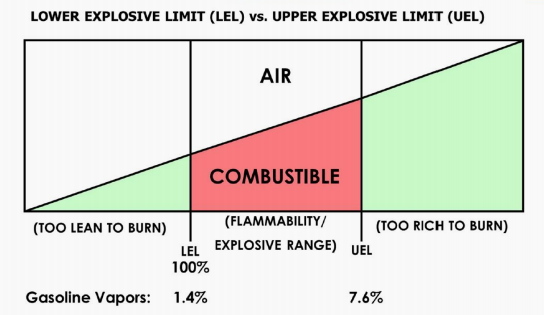
FAMILIARIZE.
FAMILIARIZE.
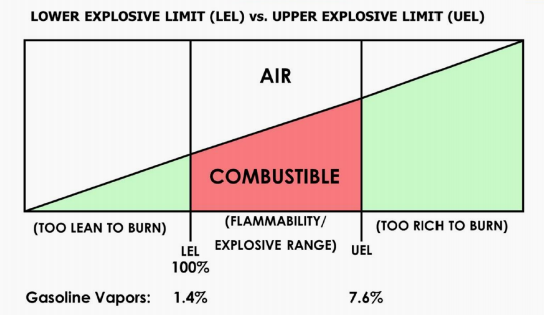
Explosion
It is a rapid expansion of gases resulting in a rapidly moving pressure or shock wave.
Mechanical (by means of a sudden rupture of a pressurized vessel)
Result of a rapid chemical reaction
Expansion of gases can be (2):
Mechanical explosion
Deflagration
Detonation
Confined explosion
Unconfined explosion
Boiling-liquid expanding-vapor explosion
Dust explosion
Enumerate the seven (7) types of explosions mentioned in the module.
Mechanical explosion
TYPES OF EXPLOSIONS. Determine what is being asked below.
It is an explosion resulting from the sudden failure of a vessel containing high-pressure nonreactive gas.
Deflagration
TYPES OF EXPLOSIONS. Determine what is being asked below.
It is an explosion in which the reaction front moves at a speed less than the speed of sound in the unreacted medium.
Detonation
TYPES OF EXPLOSIONS. Determine what is being asked below.
It is an explosion in which the reaction front moves at a speed greater than the speed of sound in the unreacted medium.
Confined explosion
TYPES OF EXPLOSIONS. Determine what is being asked below.
It is an explosion occurring within a vessel or a building.
Confined explosion
TYPES OF EXPLOSIONS. Determine what is being asked below.
It is the most common and usually result in injury to the building inhabitants and extensive damage.
Unconfined explosion
TYPES OF EXPLOSIONS. Determine what is being asked below.
It occurs in the open.
Unconfined explosion
(ADDITIONAL: The gas is dispersed and mixed with air until it comes in contact with an ignition source.)
TYPES OF EXPLOSIONS. Determine what is being asked below.
It is usually the result of a flammable gas spill.
True
(EXPLANATION: This is because the explosive material is frequently diluted below the LFL by wind dispersion.)
TRUE OR FALSE. Unconfined explosions are rarer than confined explosions.
Unconfined explosion
TYPES OF EXPLOSIONS. Determine what is being asked below.
It is mostly destructive because large quantities of gas and large areas are frequently involved.
Boiling-liquid expanding-vapor explosion (BLEVE)
TYPES OF EXPLOSIONS. Determine what is being asked below.
It occurs if a vessel that contains a liquid at a temperature above its atmospheric pressure boiling point ruptures.
Boiling-liquid expanding-vapor explosion (BLEVE)
(ADDITIONAL: As the tank contents heat, the vapor pressure of the liquid within the tank increases and the tank’s structural integrity is reduced because of the heating. If the tank ruptures, the hot liquid volatilizes explosively.)
TYPES OF EXPLOSIONS. Determine what is being asked below.
It occurs when an external fire heats the contents of a tank of volatile material.
Subsequent BLEVE
TYPES OF EXPLOSIONS. Determine what is being asked below.
It is the explosive vaporization of a large fraction of the vessel contents; possibly followed by combustion or explosion of the vaporized cloud if it is combustible.
Dust explosion
(ADDITIONAL: Many solid materials (including common metals such as iron and aluminum) become flammable when reduced to a fine powder.)
TYPES OF EXPLOSIONS. Determine what is being asked below.
It results from the rapid combustion of fine solid particles.
Vapor cloud explosions (VCEs)
TYPES OF EXPLOSIONS. Determine what is being asked below.
These are explosions that occur because of the release of flammable vapor over a large volume.
Deflagrations
TYPES OF EXPLOSIONS. Determine what is being asked below.
VCEs are most commonly ___.
Shock wave
It is an abrupt pressure wave moving through a gas.
Strong wind
A shock wave in open air is followed by a ___.
Shock wave
It is expected from highly explosive materials, such as TNT, but it can also occur from the sudden rupture of a pressure vessel.
False
(EXPLANATION: The process becomes adiabatic.)
TRUE OR FALSE. The pressure increase in the shock wave is so rapid that the process is mostly isothermal.
Blast wave
It is the combined shock wave and strong wind.
Blast wave
It refers to the pressure wave propagating in air.
Overpressure
It is the pressure on an object as a result of an impacting shock wave.
Minimum ignition energy (MIE)
It is the minimum energy input required to initiate combustion.
True
TRUE OR FALSE. All flammable materials (including dusts) have MIEs.
Specific chemical or mixture
Concentration
Pressure
Temperature
The MIE depends on four (4) variables, which are:
TNT equivalency
It is a simple method for equating a known energy of a combustible fuel to an equivalent mass of TNT.
1,120 cal/g = 4,686 kJ/kg = 2,016 BTU/lbm
A typical value for the energy of explosion of TNT is ___.
READ.
Under TNT Equivalency,
The approach is based on the assumption that an exploding fuel mass behaves like exploding TNT on an equivalent energy basis.
The heat of combustion for the flammable gas can be used in place of the energy of explosion for the combustible gas.
READ.
Under TNT Equivalency,
The approach is based on the assumption that an exploding fuel mass behaves like exploding TNT on an equivalent energy basis.
The heat of combustion for the flammable gas can be used in place of the energy of explosion for the combustible gas.
False
(Explanation: The blast wave resulting from a chemical explosion is generated by the rapid expansion of gases at the explosion site.)
TRUE OR FALSE. The shock wave resulting from a chemical explosion is generated by the rapid expansion of gases at the explosion site.
Thermal heating of the reaction products
The change in the total number of moles by reaction
The blast wave resulting from a chemical explosion can be caused by two (2) mechanisms:
READ.
Under energy of chemical explosions,
The energy released during a reaction explosion is computed using standard thermodynamics.
The released energy is equal to the work required to expand the gases. This expansion work is a form of mechanical energy.
READ.
Under energy of chemical explosions,
The energy released during a reaction explosion is computed using standard thermodynamics.
The released energy is equal to the work required to expand the gases. This expansion work is a form of mechanical energy.
Missiles
These are frequently a means by which an accident propagates throughout a plant facility, where an localized explosion in one part of the plant projects debris throughout the plant.
READ.
Under missile damages,
An explosion occurring in a confined vessel or structure can rupture the vessel or structure, resulting in the projection of debris over a wide area.
This debris, or missiles, can cause appreciable injury to people and damage to structures and process equipment.
This debris strikes storage tanks, process equipment, and pipelines, resulting in secondary fires or explosions.
Unconfined explosions also create missiles by blast wave impact and subsequent translation of structures.
READ.
Under missile damages,
An explosion occurring in a confined vessel or structure can rupture the vessel or structure, resulting in the projection of debris over a wide area.
This debris, or missiles, can cause appreciable injury to people and damage to structures and process equipment.
This debris strikes storage tanks, process equipment, and pipelines, resulting in secondary fires or explosions.
Unconfined explosions also create missiles by blast wave impact and subsequent translation of structures.
Probit (probability unit) analysis
Blast damage effects are estimated using ___.
READ.
Under blast damage to people,
People can be injured by explosions from direct blast effects (including overpressure and thermal radiation or indirect blast effects (mostly missile damage).
READ.
Under blast damage to people,
People can be injured by explosions from direct blast effects (including overpressure and thermal radiation or indirect blast effects (mostly missile damage).
Vapor cloud explosions (VCEs)
It is the most dangerous and destructive explosions in the chemical process industries.
Sudden release of a large quantity of flammable vapor (typically this occurs when a vessel, containing a superheated and pressurized liquid, ruptures)
Dispersion of the vapor throughout the plant site while mixing with air
Ignition of the resulting vapor cloud
Vapor cloud explosions (VCEs) occur in a sequence of steps (3):
BLEVE
It is a special type of accident that can release large quantities of materials.
BLEVE
It occurs when a tank containing a liquid held above its atmospheric pressure boiling point ruptures, resulting in the explosive vaporization of a large fraction of the tank contents.
BLEVEs
These are caused by the sudden failure of the container as a result of any cause.
Fire
The most common type of BLEVE is caused by ___.
READ.
Under BLEVE,
The most common type of BLEVE is caused by fire. The steps are as follows:
A fire develops adjacent to a tank containing a liquid.
The fire heats the walls of the tank.
The tank walls below liquid level is cooled by the liquid, increasing the liquid temperature and the pressure in the tank.
If the flames reach the tank walls or roof where there are only vapor and no liquid to remove the heat, the tank metal temperature rises until the tank loses its structural strength.
The tank ruptures, explosively vaporizing its contents.
READ.
Under BLEVE,
The most common type of BLEVE is caused by fire. The steps are as follows:
A fire develops adjacent to a tank containing a liquid.
The fire heats the walls of the tank.
The tank walls below liquid level is cooled by the liquid, increasing the liquid temperature and the pressure in the tank.
If the flames reach the tank walls or roof where there are only vapor and no liquid to remove the heat, the tank metal temperature rises until the tank loses its structural strength.
The tank ruptures, explosively vaporizing its contents.
READ.
Under BLEVE,
If the materials are flammable, a VCE might result. If they are toxic, a large area might be subjected to toxic materials. For either situation, the energy released by the BLEVE process itself can result in considerable damage.
If the liquid is flammable and a fire is the cause of the BLEVE, the liquid may ignite as the tank ruptures. Often, the boiling and burning liquid behaves as a rocket fuel, propelling vessel parts for great distances.
If the BLEVE is not caused by a fire, a vapor cloud might form, resulting in a VCE. The vapors might also be hazardous to personnel by means of skin burns or toxic effects.
When a BLEVE occurs in a vessel, only a fraction of the liquid vaporizes; the amount depends on the physical and thermodynamic conditions of the vessel contents.
READ.
Under BLEVE,
If the materials are flammable, a VCE might result. If they are toxic, a large area might be subjected to toxic materials. For either situation, the energy released by the BLEVE process itself can result in considerable damage.
If the liquid is flammable and a fire is the cause of the BLEVE, the liquid may ignite as the tank ruptures. Often, the boiling and burning liquid behaves as a rocket fuel, propelling vessel parts for great distances.
If the BLEVE is not caused by a fire, a vapor cloud might form, resulting in a VCE. The vapors might also be hazardous to personnel by means of skin burns or toxic effects.
When a BLEVE occurs in a vessel, only a fraction of the liquid vaporizes; the amount depends on the physical and thermodynamic conditions of the vessel contents.
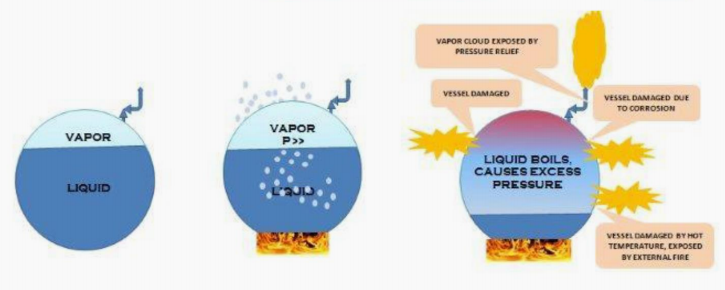
FAMILIARIZE (BLEVE).
FAMILIARIZE (BLEVE).

Prevent the initiation of the fire or explosion, and
Minimize the damage after a fire or explosion has occurred.
Enumerate the twofold strategy used to limit the potential damage from fires and explosions.
Inerting
Use of the flammability diagram
Controlling static electricity
Ventilation
Explosion-proof equipment and instruments
Sprinkler systems
Common methods in fire and explosion prevention include (6):
Inerting
METHODS IN FIRE AND EXPLOSION PREVENTION. Determine what is being asked below.
It is the process of adding an inert gas to a combustible mixture to reduce the concentration of oxygen below the limiting oxygen concentration (LOC).
Nitrogen or carbon dioxide
(ADDITIONAL: Steam is sometimes used, as well.)
METHODS IN FIRE AND EXPLOSION PREVENTION. Determine what is being asked below.
The inert gas is usually ___ or ___.
10%, 8%
METHODS IN FIRE AND EXPLOSION PREVENTION. Determine what is being asked below.
For many gases, the LOC is approximately ___, and for many dusts, it is approximately ___.
Inerting system
METHODS IN FIRE AND EXPLOSION PREVENTION. Determine what is being asked below.
It is required to maintain an inert atmosphere in the vapor space above the liquid.
READ.
Under inerting,
Inerting begins with an initial purge of the vessel with inert gas to bring the oxygen concentration down to safe concentrations.
After the empty vessel has been inerted, the flammable material is charged.
READ.
Under inerting,
Inerting begins with an initial purge of the vessel with inert gas to bring the oxygen concentration down to safe concentrations.
After the empty vessel has been inerted, the flammable material is charged.
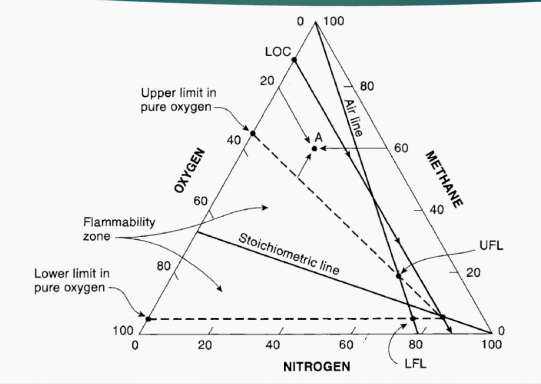
FAMILIARIZE (Flammability diagram).
FAMILIARIZE (Flammability diagram).
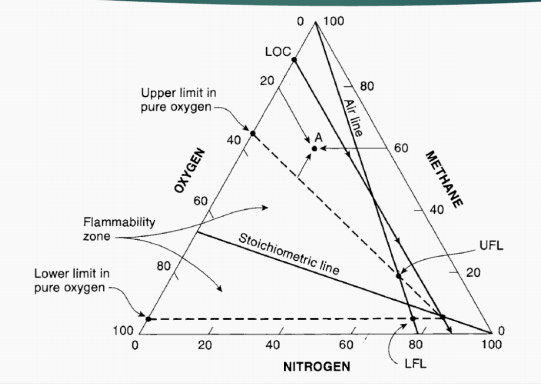
Inerting
METHODS IN FIRE AND EXPLOSION PREVENTION. Determine what is being asked below.
It is the most effective and reliable method for preventing ignition.
Inerting
METHODS IN FIRE AND EXPLOSION PREVENTION. Determine what is being asked below.
It is always used when working with flammable liquids that are 5°C (or less) below the flash point (closed cup).
True
TRUE OR FALSE. Charge buildup, resulting sparks, and the ignition of flammable materials is an inevitable event if control methods are not appropriately used.
Sparks by eliminating the buildup and accumulation of static charge
Ignition by inerting the surroundings
Design engineers install special features to prevent:
READ.
Under general design methods for preventing electrostatic ignitions,
The design objective is to prevent the buildup of charges on a product (liquid or powder) as well as on surrounding objects (equipment or personnel). For every charged object, there exists its oppositely charged counterpart.
READ.
Under general design methods for preventing electrostatic ignitions,
The design objective is to prevent the buildup of charges on a product (liquid or powder) as well as on surrounding objects (equipment or personnel). For every charged object, there exists its oppositely charged counterpart.
READ.
Under controlling static electricity,
Three methods are used to achieve this design objective:
Prevent charges from accumulating to dangerous levels by reducing the rate of charge generation and increasing the rate of charge relaxation. This method is generally used when handling liquids.
Prevent charges from accumulating to dangerous levels by designing the system to include charge reduction by means of low-energy discharges. This method is generally used when handling powders.
When dangerous discharges cannot be eliminated, then prevent the possibility of an ignition by maintaining oxidant levels below the combustible levels (inerting) or by maintaining fuel levels below the LFL or above the UFL. Measures to mitigate the consequences of an explosion are also options for consideration (For example, deflagration venting and explosion suppression).
READ.
Under controlling static electricity,
Three methods are used to achieve this design objective:
Prevent charges from accumulating to dangerous levels by reducing the rate of charge generation and increasing the rate of charge relaxation. This method is generally used when handling liquids.
Prevent charges from accumulating to dangerous levels by designing the system to include charge reduction by means of low-energy discharges. This method is generally used when handling powders.
When dangerous discharges cannot be eliminated, then prevent the possibility of an ignition by maintaining oxidant levels below the combustible levels (inerting) or by maintaining fuel levels below the LFL or above the UFL. Measures to mitigate the consequences of an explosion are also options for consideration (For example, deflagration venting and explosion suppression).
Relaxation
METHODS TO CONTROL STATIC ELECTRICITY. Determine what is being asked below.
When pumping fluids into a vessel through a pie on top of the vessel, the separation process produces a streaming current, which is the basis for charge buildup. It is possible to substantially reduce this electrostatic hazard by adding an enlarged section of pipe just before entering the tank. This hold provides times for charge reduction by ___.
Bonding and grounding
METHODS TO CONTROL STATIC ELECTRICITY. Determine what is being asked below.
It reduces the voltage of an entire system to ground level or zero voltage. It also eliminates the charge buildup between various parts of a system, eliminating the potential for static sparks.
Zero
METHODS TO CONTROL STATIC ELECTRICITY. Determine what is being asked below.
The voltage difference between two conductive materials is reduced to ___ by bonding one end of a conducting wire to one of the materials and bonding the other end to the second material.
Ground
METHODS TO CONTROL STATIC ELECTRICITY. Determine what is being asked below.
When comparing sets of bonded materials, the sets may have different voltages. The voltage difference between sets is reduced to zero by bonding each set to ___.
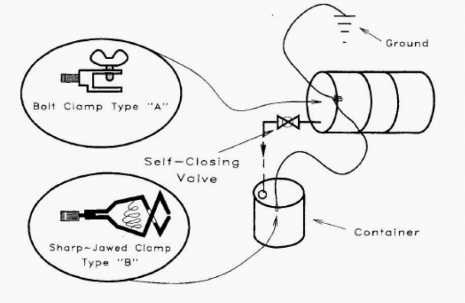
FAMILIARIZE (Bonding and grounding).
FAMILIARIZE (Bonding and grounding).
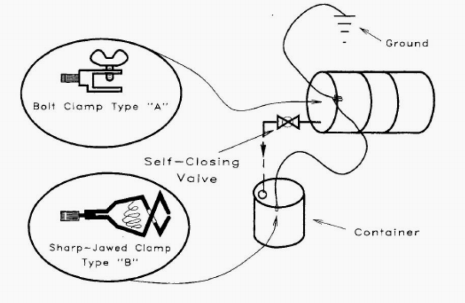
Dip pipe or dip leg
METHODS TO CONTROL STATIC ELECTRICITY. Determine what is being asked below.
It is an extended line that reduces the electrical charge that accumulates when liquid is allowed to free fall.
READ.
Under dip pipes,
When using dip pipes, care must be taken to prevent siphoning back when the inlet flow is stopped.
A commonly used method is to place a hole in the dip pipe near the top of the vessel.
Another technique is to use an angle iron instead of a pipe and to let the liquid flow down the angle iron. These methods are also used when filling drums.
READ.
Under dip pipes,
When using dip pipes, care must be taken to prevent siphoning back when the inlet flow is stopped.
A commonly used method is to place a hole in the dip pipe near the top of the vessel.
Another technique is to use an angle iron instead of a pipe and to let the liquid flow down the angle iron. These methods are also used when filling drums.
Ventilation
METHODS IN FIRE AND EXPLOSION PREVENTION. Determine what is being asked below.
Its purpose is to dilute the explosive vapors with air to prevent explosion and to confine the hazardous flammable mixtures.
READ.
Under ventilation,
Open-air plants are recommended because the average wind velocities are high enough to safely dilute volatile chemical leaks that may exist within a plant.
Although safety precautions are always practiced minimizing leaks, accidental releases from pump seals and other potential release points.
READ.
Under ventilation,
Open-air plants are recommended because the average wind velocities are high enough to safely dilute volatile chemical leaks that may exist within a plant.
Although safety precautions are always practiced minimizing leaks, accidental releases from pump seals and other potential release points.
Frequently, processes cannot be constructed outside. In this case, local and dilution ventilation systems are required.
Local ventilation
METHODS IN FIRE AND EXPLOSION PREVENTION. Determine what is being asked below.
It is the most effective method for controlling flammable gas releases.
Dilution ventilation
METHODS IN FIRE AND EXPLOSION PREVENTION. Determine what is being asked below.
It is used when the potential points of release are numerous and may be mechanically or economically impossible to cover every potential release point with only local ventilation.
True
TRUE OR FALSE. All electrical devices are inherent ignition sources.
True
TRUE OR FALSE. The fire and explosion hazard is directly proportional to the number and type of electrically powered devices in a process area.
XP
Non-XP
Process areas are divided into two (2) major types of environments:
XP (for explosion proof)
MAJOR TYPES OF ENVIRONMENTS IN PROCESS AREAS. Determine what is being described below.
It means flammable materials (particularly vapors) might be present at certain times.
Non-XP
MAJOR TYPES OF ENVIRONMENTS IN PROCESS AREAS. Determine what is being described below.
It means that flammable materials are not present, even under abnormal conditions.
Sprinkler systems
METHODS IN FIRE AND EXPLOSION PREVENTION. Determine what is being asked below.
These systems consist of an array of sprinkler heads connected to a water supply.
READ.
Under sprinkler system,
Sprinkler systems are an effective way to contain fires.
The heads are mounted in a high location (usually near ceilings) and disperse a fine spray of water over an area when activated.
READ.
Under sprinkler system,
Sprinkler systems are an effective way to contain fires.
The heads are mounted in a high location (usually near ceilings) and disperse a fine spray of water over an area when activated.
Wet-pipe system
Deluge system
Enumerate the two (2) methods of activating sprinkler heads.
Wet-pipe system
METHODS OF ACTIVATING SPRINKLER HEADS. Determine what is being asked below.
It activates the heads individually by the melting of a fusible link holding a plug in the head assembly.
Wet-pipe system
METHODS OF ACTIVATING SPRINKLER HEADS. Determine what is being asked below.
In this system, the sprinklers cannot be turned off unless the main water supply is stopped once activated.